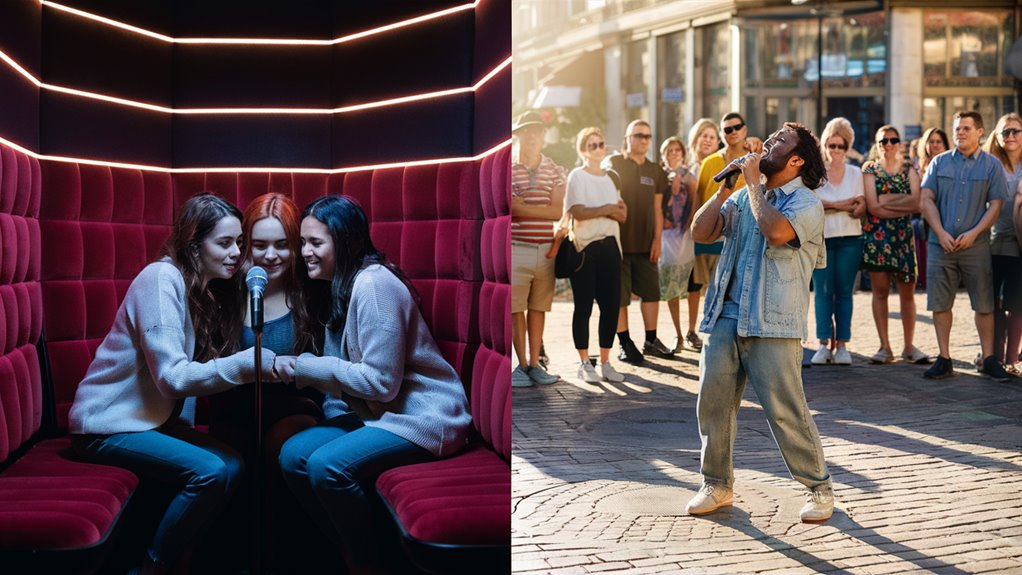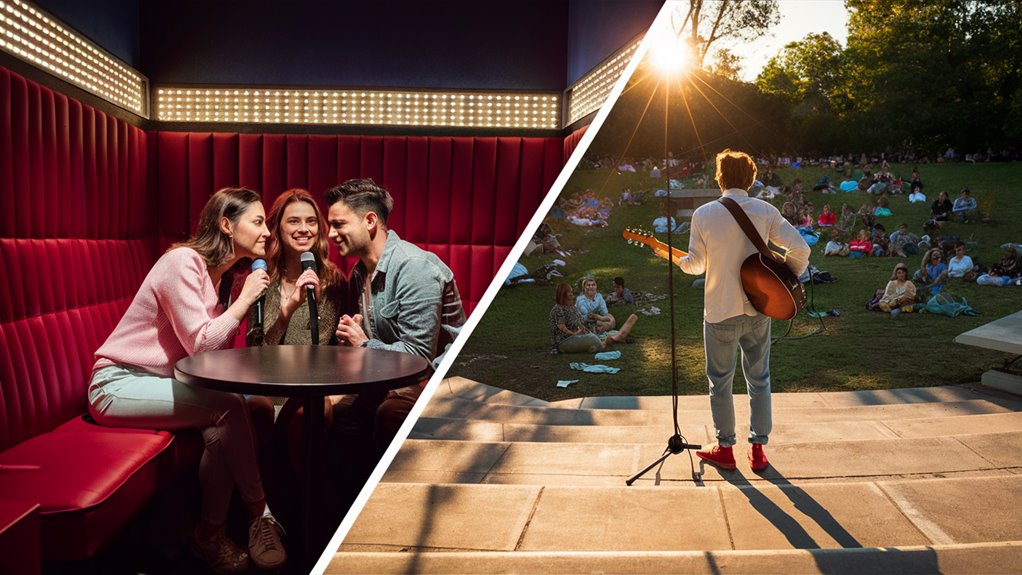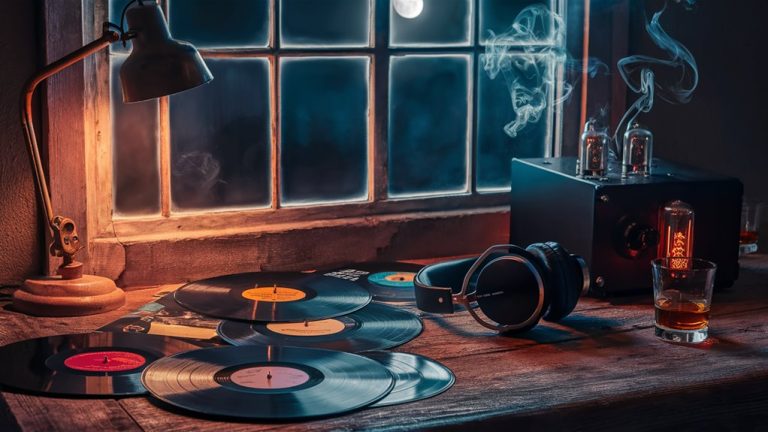
Private and Public Singing: A Comprehensive Comparison
Two Arena Options and Money Matters
Private karaoke rooms generally range from $30 to $100 an hour. This creates an intimate setting that is perfect for experimentation and casual crooning. In these carefully controlled spaces, you have immediate access to extensive song libraries as well as professional equipment, which makes them ideal both for beginners trying things out and experienced singers who need practice time.
Private karaoke experience
Contrast: Private karaoke complexes depreciate interest when you gain no control over the atmosphere.
At present, there is unlimited song selection and worldwide popularization around the corner.
Success is flexible.
The psychological burden is lessened.
Group-friendly.
Public Performance Venues
Performing publicly offers special benefits.
Class systems from professional sound and ultimately free clubs.
Realistic atmosphere of amusement likelihood.
Structured performance slots.
Networking opportunities.
Also, crowds.
How to Make Your Choice
Consider the following points when trying to come to a decision:
- Comfortableness performing in public
- What your musical goals and requirements for learning to perform are
- What sort of atmosphere suits you best socially
- Budgetary restrictions and finances
- How much time practice can you afford?
Professional Development Opportunity
There are many opportunities for you at public venues to grow industrially:
- In this context, those who have connections
- Portfolio building from one’s performances
- Stage presence
- Experience with various pieces of technical gear
- A live audience
What you need depends on your particular situation, aims, and feelings about public speaking.
The Social Facet
The Social Aspect of Performance Venues
Karaoke social dynamics
The social dynamics of karaoke settings give a uniquely satisfying experience to performers and audiences alike.
Karaoke establishments create a distinct and encouraging environment for both singers and listeners alike. Strangers in the crowd with your same musical hobby make sure you are not nervous.
In addition, these setups are specifically set up to have all levels of skill participate. Performers share a public atmosphere so universal that their live performances no longer have any barriers or status quo that need not be met.
Professional Venues
The social dynamics of public singing venues and formal performance spaces are more widely predictable and different in their essence.
These establishments create a clear division between performers and audiences. As regards quality and rehearsal, both are significantly higher. The concentrated attention from audiences gives performers a more judgmental atmosphere in terms of making an evaluation on their own work. It also generates greater comfort for them.
Opportunities Social Networking
The karaoke establishment is a place where encounters are easily struck up among casual acquaintances, with singers building amicable relations built upon shared musical memories.
In contrast, in performance halls that engage professional performers, many musical opportunities occur as performing musicians mingle with the audience or meet with industry people to foster career advancement and artistic development. Bearing in mind this distinction between social environments for one’s trade gives performers an understanding of where they can best put it to use.
Key SEO Terms: karaoke environments, performance venues, professional performances, social dynamics, professional and business opportunities (career advancement and artistic development), performer-audience relationships, musical networking, venue atmosphere.
Cost and Accessibility Comparisons
Cost and Accessibility Comparison: Karaoke vs Nightclub Singing Venues
Analysis on Costs of Singing Venues
Nightclubs are no great burden on performance sounds, though they tend to encourage people to retract further into them by charging performers for the service.
Private karaoke rooms generally charge by the hour, at rates ranging from $30.00 to $100 an hour. However, pricing varies with room capacity and location.
These costs can easily add up to exceed the cost of hiring an equivalent public hall and orchestra for each individual concert one performs in the future.
Public Performance Venues and Economic Rationality
In public singing sites, there are many fulfillable opportunities for new performers who would otherwise have to pay.
Every public house opens its own ‘open-mike night’, where admission is free but purchases are minimal.
Local karaoke bar memberships are very reasonably priced, while church choirs are free; this makes them good for the thrifty singer to avail himself, with these alternatives acting as extremely budget-friendly options.
Geographical Accessibility and Substitutes Online
The venue limits its accessibility by location and vocality.
Nightclub-type karaoke lounges are concentrated mainly in urban centers. Consequently, people of suburban or rural existence feel the places to be out of reach.
Community centers, church buildings, local entertainment halls offer outwardly distributed public performance spaces that satisfy the prerequisite of location accessibility.
With the advent and proliferation online of karaoke websites, singers lacking funds can pay a mere $20 a month for areas complete with all the trimmings. For cheap it may be, but did those who selected the digital option really think that karaoke podcasting and downloading would just exactly match a traditional hangout experience in every respect?… Surely not!
Choosing a Venue: Four Critical Factors
- Location (proximity)
- Budget constraints
- Purpose in performing
- Scent and visual attractiveness inside The Best Karaoke Bars for Large Groups and Corporate Events the venue
- Transportation accessibility
Performance Pressure: A Different Look
Performance Pressure in Singing Environments
Karaoke and Anxiety about Public Performance
The psychological response to performance pressure is different depending on the particular performance environment.
In a karaoke setting, there is thus a unique anti-performance atmosphere; everyone—from the singer to the sympathetic stranger in street clothes—tries to outdo each other in sounds peculiar and hilarious. Absolutely nobody feels any tension at all.
Professional Performance Expectations
There is more performance pressure from the audience of any kind when one sings in public contexts.
In the concert theatre or concert hall, one needs to be performing “thoroughly professionally” in every department. This makes precise technical achievement and artistic creativity unrivaled. Such formal surroundings usually give a high public airing to stage fright among performers who are harshly judged by audiences at the pinnacle of taste.
Technology and Support for Performance
Benefits to karaoke technology
Audience members
Sound reinforcement
Higher degree recording atmosphere
Public Performance Needs
Ming ren pre, or traditionally
Pure mental comfort song
Efficient song
Providing a cappella accompaniments
Karaoke venues present a safety net for performers
Conversely, traditional public performances mean personal skills and preparation are the only things a performer can count on. This vital difference in how support is provided gives rise to different levels of anxiety for performers in each of these two environments.
Song Choices and Control
Song Choice and Control in Performance Environments

Karaoke Song Choice Experience
Song choice flexibility distinguishes the karaoke environment. Performers have access to vast digital databases covering multiple styles, genres, decades, and artists.
With this varied selectivity, however, singers can choose songs to suit their own pitch range and style best. And karaoke bars make sure that artists stay in their own sphere by providing a controlled environment where vocal numbers are lip-synched if necessary—but never overshadowed into oblivion. Thus, although it serves the needs of performers, this is not an environment conducive to creative change or musical compositions by any means!
Considerations for Public Performance
A public singing location poses entirely separate requirements for choosing songs. These performance environments—choir where everyone has a part, open mic nights with drunk hicks and surly poets of all kinds doing what they do in hushedly expectant murmurs of ‘tameness, tameness’—all inherently include elements external to oneself which then form repertoire choices inferentially. Performers must work around:
- Pre-planned programs
- The conductor’s directives
- Band coordination
- Musical arrangement needs
Strategic Selection Benefits
Processes of selection for karaoke entertainment venues are very different from those used in public performances. Karaoke sites the singers drive: Besides the immediacy of song selection, the release of an already chosen number for oneself is swift and personal; on top of it all, whichever numbers a particular club adopts that night become your number. You’ll sing it with heart and soul if it’s yours too; such moves beget storms at unexplored heights of your existence—or lullabies to babies fortunate enough not to have yet been born!
Karaoke sites the venue’s executioners deliver. Besides the immediacy of song selection, professional performances also produce:
- Developing musical skills
- Expanding your song lines
- Opportunities for professional musical growth
- A shared experience
Making the Right Choice
Knowing the exact characteristics of these venues allows the singer to select one most suited to his purposes. Karaoke or informal entertainment venues are best for those who put freedom of song choice first, and want the environment to make them comfortable. Music performers at literate venues, then, have a different experience. They’re working in a structured mode with company promotion and human resources to help them grow further both professionally and musically. https://getwakefield.com/
Sound Quality and Equipment in Performance Venues
Professional Venue Audio Systems vs Karaoke Equipment
A different audio world nowadays is left for karaoke places and formal performances by modern technology.
Karaoke systems feature vocal enhancement tech—now in-fashion these years, smashed together with hardware effects like that built into new gear for motor homes to spruce up their architecture. Such modifications improve amateur performances and make faux ha-ha sound someone less in misery over a fault of her voice.
Professional Quality Audio Systems for Public Performances
Theatres tools for performance venues employ high-quality audio systems for professional orchestral performances. Such sophisticated arrangements can provide top-quality sound reproduction through:
- High-quality speaker arrays
- Professional mixing consoles
- A dedicated crew of sound men, all at your service
- Real-time audio controls
Top Karaoke Facilities and Their Equipment
Top-end karaoke halls now incorporate digital mixing boards and other advanced audio tech including:
- Feedback killing units
- Vocal enhancement machines
- Various sorts of microphones
Equipment Operation Best Practices
Quality of performance—optimal performance in fact—depends upon skill and knowledge regarding:
- Proper microphone technique
- Volume control
- Monitors
- Basic troubleshooting methods
Work program karaoke places may use just an ordinary general-purpose amplifier, whilst theatres will have a full-thorough sound reinforcement set up available for every function.
Time Management and Length
Time Management: Karaoke vs. Public Singing
Length Differences between Performance Venues
At karaoke performances, one sings three to five minutes for a song and then quickly rotates to the next performer.
At most karaoke parlors, there are only certain times of day when it is impossible to be ignored by everyone else as it plays on. Whether this includes slow days such as Monday and Sunday afternoons or when the house is packed with customers who have been waiting to go to do their singing all week long, none ever want your microphone turned off.
Professional performances go over longer periods of time
Performances in public sites are scheduled for well-defined time slots.
These range from 15 to 45 minutes and allow performers to present a variety of pieces and meaningful audience interaction.
Concert halls and the open microphone nights provide performers with whole time periods dedicated to complete artistic expression.
Strategic Concerns for Time Management
Pros of karaoke performance
- Quick performance turnarounds
- Immediate audience acclamation
- Consequential song rotation system
- Pressure off performance.
Advantages of Public Performance
- Longer time on stage
- Many songs to continue learning
- Firming an audience connection
- Professional control of time.
As the time stretches from the short burst of karaoke to full-length public presentation, the basic quality of timing becomes increasingly important.
Those who start in karaoke can benefit from the structured nature of the show before moving on to a place where timing is more essential and one has to understand management techniques for concerts.
Creating the Perfect Atmosphere for Performance
Creating a Perfected Performance Atmosphere
Optimization of Karaoke Venues
Lighting is the key aspect of karaoke combination. The best installation requires light balanced immediately—dim enough for atmosphere and bright enough to read lyric texts clearly.
A degree of 72°F (22°C) maintains the vocal environment but avoids heat from stage lighting affecting its working well.
Professional Stage Needs
The lighting configuration on the stage requires precise planning, with one primary spotlight and several strategically placed fill lights that eliminate undesirable shadows.
The humidity in the venue shall not exceed between 40 and 50% so as not to harm the vocal channels and equipment.
In order to optimize the EQ settings properly before going on stage, it is essential to check the sound system all over the venue beforehand so as to adjust and remove any feedback that may occur.
Sound Cabinets
Sound control is different in different types of venues. A booth asks for sound-absorbing materials such as the wallboard on the ceiling to reborn sound.
Professional venues require high-quality sound support systems employing on-axis electrostatic monitors.
Great care is taken with the microphone return stage, adjusting the sensitivity and reverb settings so as to avoid vocal tension.
Good sound insulation means performers can stick to their own pitch and general singing at any time of the performance will not suffer.



